Let’s face it.
Most SaaS content writing doesn’t work.
The content fails for one of four reasons:
Reason 1: The content just isn’t very good. It’s written by AI or some low cost blog writer without any subject matter experience.
Reason 2: There’s no plan in place to get traffic. We’re an SEO agency, so most of our content is designed to rank in order to get traffic. But you could run ads to your content, leverage it in newsletters and social channels.
Reason 3: It doesn’t convert. You want your content, no matter where it is in the funnel, to eventually convert readers into users.
Reason 4: There’s no clear goal. Again, because we deal mostly with SEO, our goal is to leverage content to increase MRR. But you could also use your content to increase brand awareness, establish yourself as a thought leader, etc.
In the rest of this article, we’re going to discuss how to leverage SaaS content writing to increase your MRR.
3 Goals of SaaS Content
For me, every great piece of SaaS writing accomplishes at least one of three goals.
First, it attracts the right type of buyers. These are people who need your product AND have the money to pay for it. (Or they have access to the person who owns the budget.)
Second, great SaaS writing builds awareness for your solution. Often a person will know they have a problem, but won’t know what the solution is.
And third, most importantly, you’ll be able to use your content to convert readers into paying users.
Let’s talk about how to achieve each of these three goals.
Attract the Right Buyers
I have a post on this site called SEMRush alternatives. I wrote it when Content Guppy was just a blog and I didn’t know what I was doing.
The post gets a ton of traffic.
But, the traffic is mostly useless.
Why?
Because it doesn’t attract people who are looking to buy SEO services. It attracts people who want to buy cheaper SEMRush alternatives.
What a bummer.
However, I also have a post called “SaaS Content Marketing” where I break down how we deployed a content marketing strategy that took a bootstrapped SaaS from 0 to $10mm ARR (and beyond).
That article attracts the right buyers.
SaaS founders and CMO’s who want to leverage content marketing to grow.
Build Awareness for Your Solution
Once you’ve got the right buyers to your site, you can use your content to build awareness for your solution.
The SEO software company AHREFS does this about as good as anyone.
For instance, have an article called “How to do Keyword Research for SEO”.
In the article, they show you step by step how to do keyword research… with their tool!
Talk about building awareness for their solution.
Oh, you have a problem? Cool! Here’s how to solve it using the tool that we built.
Convert Readers into Users
The final goal of your content is to actually make money from it.
If it’s bottom of the funnel content, then you should be able to convert the readers directly into users (or if you require a consultation, mqls.)
If it’s top of the funnel, then you may need to get readers into your newsletter or request more information in the form of a case study or ebook.
But either way, your content should have the goal of converting readers into the next logical stage of your funnel.
5 Content Archetypes
Over the course of a decade in SEO and content marketing, we’ve come up with 5 content archetypes that are designed to get your post to rank in search engines and convert readers into leads and users.
Alternative Post
The Alternative Post is one of my favorite posts to write.
And it's one of my favorites for 3 reasons:
1. It's usually not that hard to rank the post in Google
2. It brings in the most qualified traffic you could possibly ask for. Every Jiu Jitsu post we wrote, we would add two paying users per month.
3. You use the strength of your competition against them. Kind of like how a Jujitsu fighter uses their opponent's force against them. Hence the jujitsu technique :).
Here's how it works.
Let’s say you’re competing against an 800 pound gorilla.
Instead of worrying about them, use them to your advantage. One of my favorite seo content hacks is to write an article called “10 large competitor alternatives”.
Back in the day at Time Doctor, our largest competitor, the 800 pound funded gorilla is a company called Toggl. So we leveraged their brand and wrote an article called 7 Best Time Doctor Alternatives.
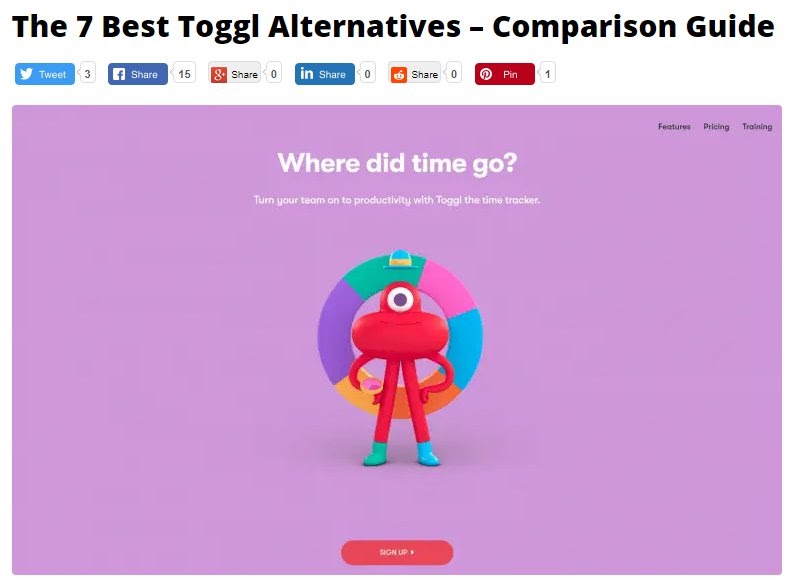
And then we put our app, Time Doctor, first on the list.
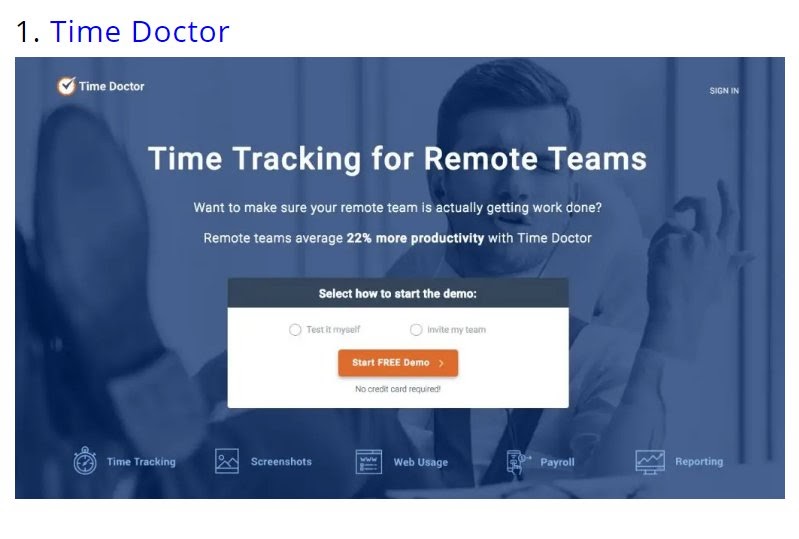
And as you can see, this post, with “low” volume gets between 200-400 visitors a month. And each of those visitors sees us as the first solution on the list!
(We must have moved up in rankings sometime in late November or early December.)

So imagine having 200-400 visitors a month looking for an alternative to your largest competitor coming to your site every single month.
This is why I love Alternative Posts.
X vs Y Post
The X vs Y post is a comparison post.
There are two ways to get this done.
First, if you have a large brand within your market, then you can compare yourself to your competitors.
For instance, our client Superhuman could write posts like “Superhuman vs Gmail”.
Or if you’re the SEO manager at Stripe, you could write “Stripe vs. PayPal”.
At TimeDoctor, once we grew, we would write posts like “Harvest vs. Time Doctor”.
But what happens if you’re just getting started and you don’t really have a big brand yet. And writing a comparison post with you and a competitor doesn’t have search volume.
Well, you can Trojan Horse your way into the article.
For instance, when I started at Time Doctor, we were on no one’s radar.
So, our comparison would be something like “Harvest vs Toggl”...

These were two heavily funded, renowned competitors back then. (They still are.)
After we wrote the post and compared Toggl to Harvest, we would then introduce Time Doctor.
Say something like “Yeah, Toggl and Harvest are good, but here’s why you should try Time Doctor…”
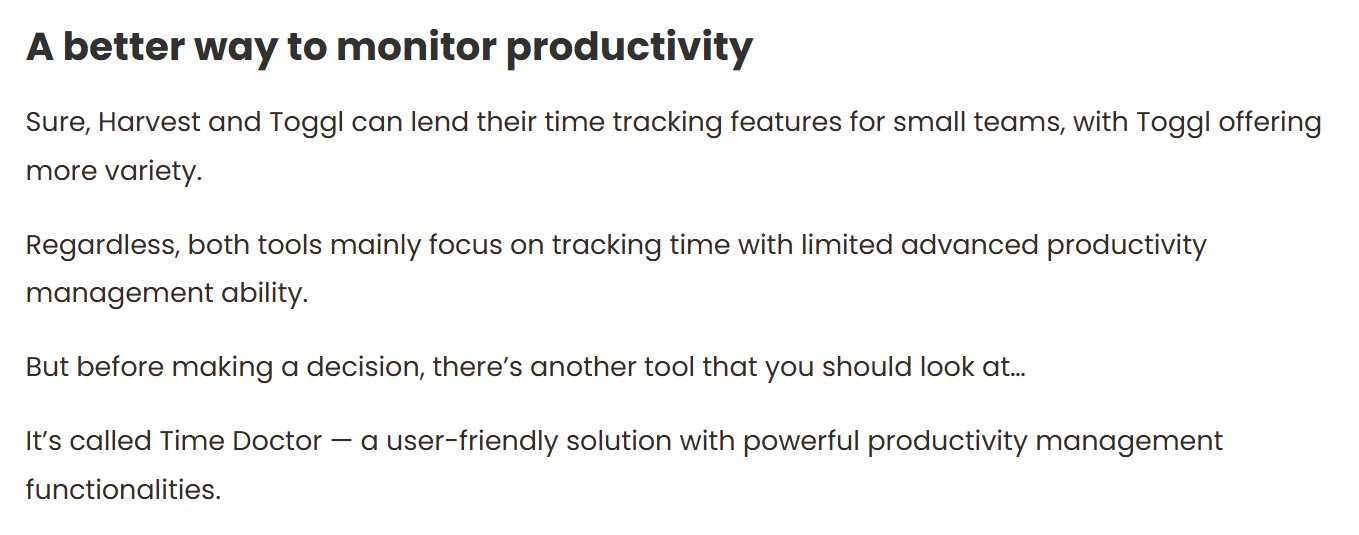
This way, we’re getting the search traffic for the Harvest vs Toggl keywords AND we’re introducing a buying audience to our product.
Best Category Post
A potential prospect is looking for a software in your industry because they have a problem they need solved.
So a business owner looking for accounting software will go to Google and ask "best accounting software".
And a list of lists will come up.
For instance:
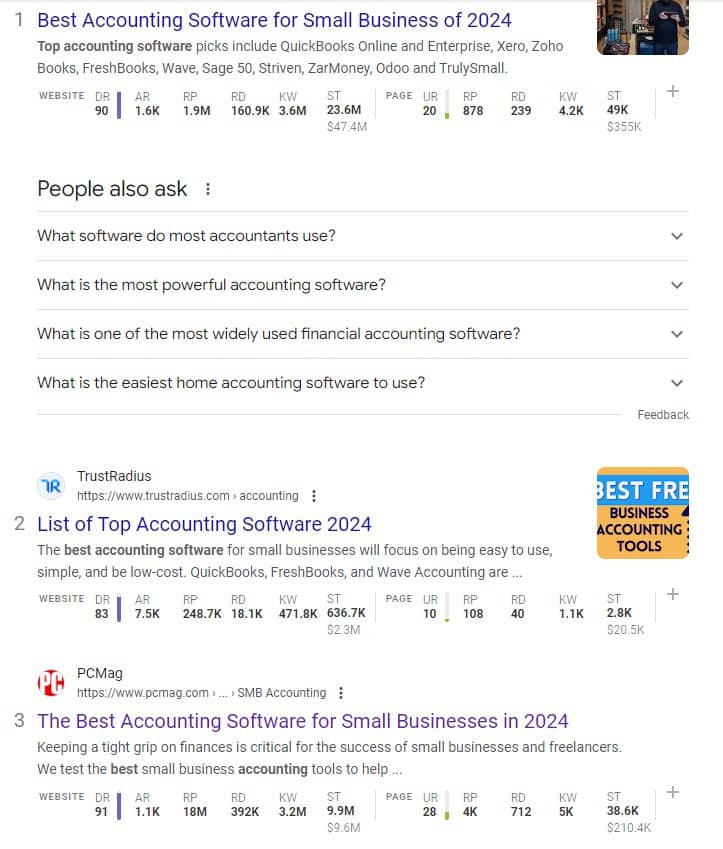
You want to create content that provides them with the answer to their question... in this case "What are the best accounting software available?"
Can you see how getting folks to your site with a list of tools that solve their problem can be a good thing? 🙂
What is a Best Category Post?
A best category post is a list post that lists the best tools in a particular category.
Think: Best accounting software, best SEO software, best email marketing software.
Pretty simple, but pretty effective.
But here's the key, you can think outside of the box. Chances are, your software belongs in multiple categories.
For instance, at Time Doctor, we were a time tracking tool for remote employees.
So, our categories could be:
- Time Tracking Tools
- Time Management Tools
- HR Tools
- HR Tools for Agencies
- HR Tools for SaaS companies
- Project Management Tools
- If you're an accounting SaaS, you can be:
- Best Accounting Tools
- Best Accounting Tools for Small Business
- Best Accounting Tools for SaaS
- Best payment processing tools (If you have a payment feature)
Think about all the types of customers you serve and all the use cases.
How to execute it for maximum results?
Headline
The headline for this type of post is quite simple. It's going to be:
[Number] [Category] [Benefit]
Number: I wouldn't go anything less than 10 here. A lot of times, I'll use 17 or 21.
Category: Sometimes when you're doing keyword research you might find that Best Accounting Software has more search volume or less competition than Best Accounting Tools.
I like to add the exact match. It's not a big deal as Google is smart enough to know that when you say "tool", you can also mean "software". But every little bit helps.
Benefit: Quickly say why someone needs this category of software for their business..
Here's some examples:
17 Best SEO Tools to Help You Rank Higher without Breaking the Bank
21 Accounting Tools to Help You do Taxes in Less Time
The 10 Email Automation Software to Grow Your Email List
About Your Tool
You're tool is going to be first! Don't be shy here. Most people won't scroll past the third tool. So if your putting yourself fourth or fifth or modesty reasons, you're leaving a lot of money on the table.
Treat this almost like a mini sales page. You can use a button as a call to action which works great or you can just link to your sign up page.
Body of Post
As for the rest of the tools, I follow a simple formula.
I will use an image that I take from the competitor's website.
I'll make a 100-200 word summary of the tool.
I'll summarize key features.
And then I'll summarize pricing.
That's it.
We recently ranked one a client’s best category post. And here’s how it’s doing:

Template Post
One of my favorite keyword research strategies is to find templates to build that are related to your product.
Here’s why I like them.
First, they attract people who need the problem that your company solves.
Second, they’ll give people an idea of how you approach the problem.
And third, they convert REALLy well.
Most people are going to just use your free template. But there will be people who don’t want to manually do things in a Google sheet - so they’ll download your tool so you can do it for them.
Let me show you an example.
We created a post called Timesheet Templates. At the time I'm writing this email, the keyword currently gets 7700 searches per month - meaning there's a huge potential for traffic there.

Then, you create a post whereby you give away the template for free. Our templates were Google sheets, PDFs, and Excel Sheets.
You can see an image below.
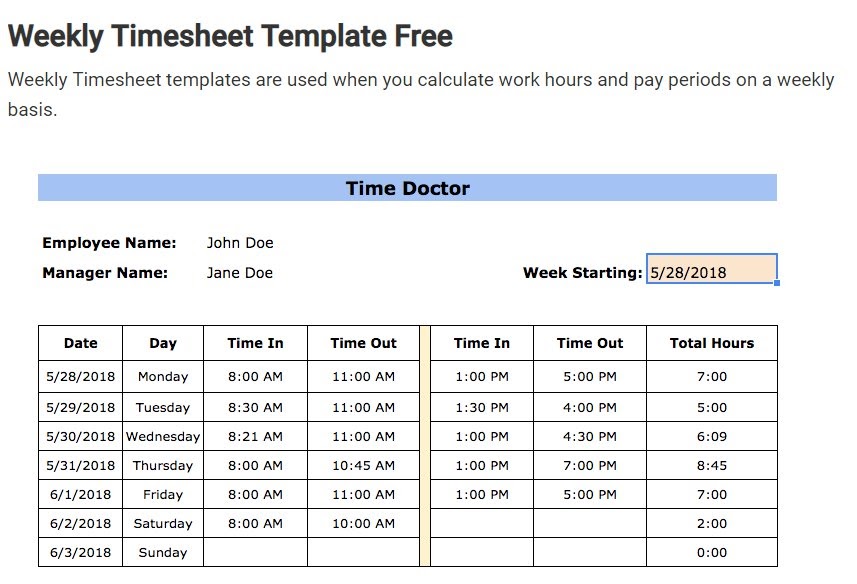
Manually managing timesheets is a real pain in the butt. It is much easier to just have a software do it for you.
Most of the people who read this post are going to just download the free template. They may eventually become customers down the road.
But there are going to be enough people who read the post, realize they don't want to be bothered by doing it manually, and sign up for the tool.
How do you do it?
Now, let's talk quickly about how to execute on this type of post.
Title:
We just kept this simple:
[Number] Free [Category] Templates You can Download and Use Today
For instance:
- 4 Free Timesheet Templates You Can Download and Use Today
- 5 Free Inventory Management Templates You Can Download and Use Today
Body:
Here's the key with this type of post. You're going to give it away for free.
Don't even collect email addresses.
Let people download or have access to the template without any gate of any kind.
We found that when you gate something like this, you lose rankings in search.
We'd much rather have the traffic to our site (we can retarget later if we want) and let them use the templates for free, than not have the traffic at all.
Your Tool:
Throughout the post, and especially at the end, you should just let people that using the template manually is a pain in the butt, and that your tool will make their life a hell of a lot easier.
Jobs to be Done Post
A user will "hire" your SaaS to complete a job faster, cheaper, better, than they would be able to if they did it manually.
A Jobs to be Done Post will show someone how to do what it is they're hiring your software to do... then show how your software does it better.
Quick note: chances are, your SaaS has many different use cases for several different types of users.
Start thinking about all the different ways your users use your SaaS and jot them down.
For instance, at Time Doctor, even though our main "thing" was time tracking for remote employees, we had the following use cases:
- Agencies would use the tool to manage projects
- Agency owners would use the tool to pay their freelancers
- Agency owners and SaaS founders would use the tool to estimate how long projects take
- Medical transcription companies would use the tool to see how much to bill clients
- Call center owners would use the tool to see how long each agent was spending on a customer service call
Here’s how to execute this
Now, let's talk quickly about how to execute on this type of post.
Title: 90% of the time, this is going to be a "how to" post.
Some Examples:
How to do Keyword Research
How to reduce churn
How to claim 1099 employees on your tax returns
Body:
Now you're going to go DEEP into the weeds on how to solve the problem using your software.
I love a "step-by-step" approach.
So if you're post is "how to do keyword research", your outline might look like this:
Step 1: How to find an topic to write about Step 2: How to figure out if the topic is worth pursuing Step 3: How to analyze the competition Step 4: How to analyze relevance Step 5: Keyword difficulty vs. Search Volume etc...
This is going to be a tutorial on how to use your product.
And the best part is: Google loves these types of posts.
Because they solve an actual problem, in depth.
Your Tool:
When you're writing this post, you're going to include screenshots, videos, gifs, etc. of your product.
You want people to feel like they CANNOT do the task properly without signing up for your SaaS.
The Tools We Use
We like to keep a very lean tech stack with our writing - and our SEO in general.
So here’s what we use.
Customer Discovery “Tools”
I put the word “tools” here in quotes because I’m not sure there’s any one tool that we use for this.
Let me explain.
We love talking to customers. They give us so many ideas for new content. Ask a customer what their challenges are, then be quiet and listen.
There’s a gold mine there.
You can use Zoom or go in person or whatever to listen to your customers.
But this is essential.
The other thing we like to do is scroll social platforms to see what challenges people are having with regards to your industry.
You’ll read things like “hey, I want to do x, does anyone have a tool that does that?”
Or, “I really hate (big brand). What’s everyone using to replace?”
These insights will give you ideas on the type of content to create AND how to position yourself against your competitors.
Ahrefs
When it comes to SaaS content writing, we use Ahrefs mostly for keyword research.
We’ll use it to find what customers are searching for, see what our competitors are ranking for, identify topics that are relevant to your business, etc.
ChatGPT
We pour a ton of time and effort into our blog posts.
Many of them are around 2500 - 3000 words long. They’re well researched.
It would be a crime to just hit “publish” on the blog and then build a few links to it.
So, we use ChatGPT to repurpose our content into newsletters and social media posts. For instance, a post like this might be repurposed into 15-20 LinkedIn posts and 3-5 newsletters.
An example:
We might take the “Jobs to Be Done” section of this post, put it into ChatGTP and say:
“Can you turn this section into 5 LinkedIn posts? One post should be educational, one post should be contrarian, one post should be step-by-step, one post should be problem-solution, and one post should be a teaser to this blog post”
That’s one section of this post: 5 LinkedIn posts.
I can easily get another 20-25 pieces of content out of this one post.
Personal Experience
OK! This is a cop out.
Kinda cheating.
Because personal experience isn’t really a “tool” that you can buy. But I had nowhere else to put it.
We like to infuse all of our posts with personal experience.
Notice how I am not mentioning writing posts with AI or ChatGTP? That’s because those tools don’t have our personal experience.
In a “content” sea of sameness, infusing your personal experience is a way to stand out.
So when you hire writers for your content, make sure they have done things related to your content.
Don’t just hire a cheap writer who’s going to give you a “well researched” blog post. You might as well just use ChatGTP for that.
SaaS Content Writing…
Can take some time, some practice, and a bit of patience.
If you’re looking to work with an agency who’s been writing for SaaS companies for over a decade, then feel free to click here and schedule a quick consultation.
We’ll show you how we can help you increase MRR in 90 days with SaaS content and SEO.



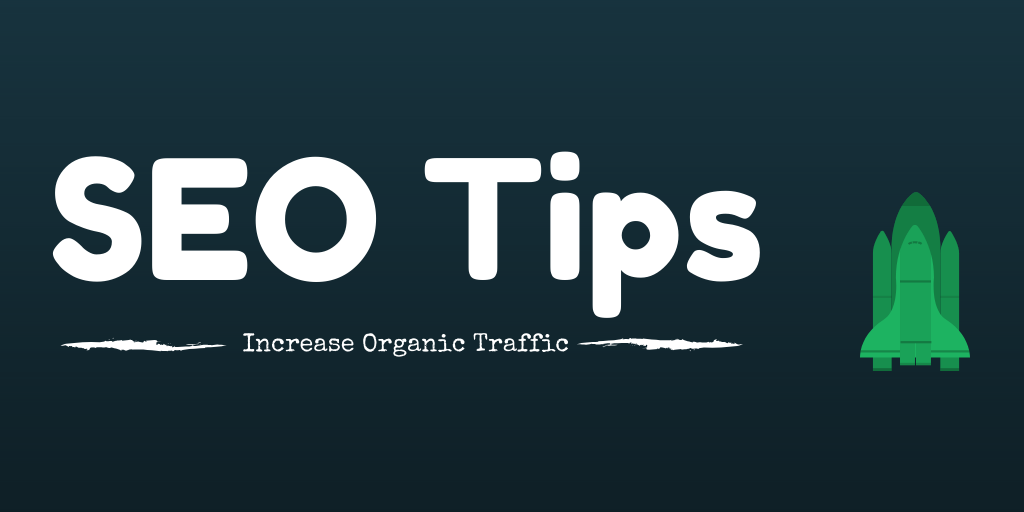
About The Author: Greg Digneo
I love helping people with their marketing. So I created this site to give you tools and information to help you grow your blog, build your audience, and get more sales.
More posts by Greg Digneo